There is a small lab on Friday Harbour, San Juan Island, just off the US state of Washington. Here, marine biologist Adam Summers spends much of his time painstakingly loading fish after fish into a CT scanner to produce detailed images that reveal their intricate skeletons and inner structures.
The project began inauspiciously several years ago when Summers would pay covert night-time visits to local hospitals, begging to use their CT scanners during periods of downtime. “We would stuff dead sharks and rays and things into bags, so nobody could tell what they were,” he says.
After amassing a library of several successful scans, he began sharing his results on Twitter. To his surprise he got a huge response, with many biologists asking him to scan their favourite fish. “I jokingly replied that I was going to #ScanAllFish,” he says.
At the time, he didn’t really believe that would happen because it was taking 12 hours to scan three or four fish, and there are more than 33,000 species to get through. But with the current total of scans standing at 3,827 he reckons the project could be completed in as little as two years, though they may have to skip a few of the biggest, rarest fish.
Thanks to the success of his images, Summers applied for a grant for his own CT scanner, which has been installed in his labs. Every scan is immediately posted online for anyone to use, with Summers not asking for any credit.
The project has already racked up more than half a million downloads, with everyone from scientists and engineers to artists and teachers using the images. “We’re exposing our data to a world of people who have great brains and will do far better things with it than we ever could,” he says.
Anyone can use the scanner to scan their favourite species, provided they make the data freely available. “If you come to the island you can bring a suitcase full of dead things and CT them,” says Summers. He is also collaborating with museums worldwide to scan their collections. It is hoped that these ‘digital dissections’ will allow people to see inside fish and manipulate them in ways that is just not possible with preserved specimens.
As well as CT scans, Summers also makes fish skeletons visible through their skin using dyes that stain bone red and cartilage blue. He bleaches the fish white with hydrogen peroxide and dissolves its flesh with the digestive enzyme, trypsin, leaving only skin and connective tissue. The fish is then photographed while immersed in glycerine, which renders the unstained parts invisible.
1
Spiny lumpsucker (Eumicrotremus orbis)
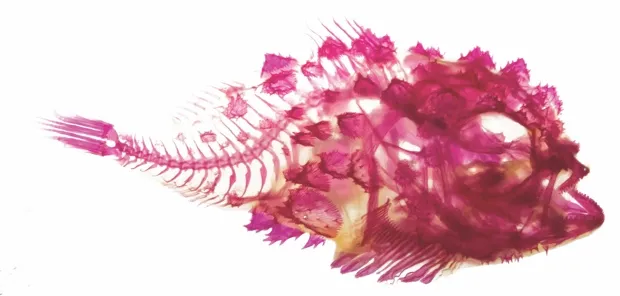
These round fish are covered in prickly, bone-like plates called tubercles. They do not swim well. Instead, they prefer to stay put, fixing themselves to rocks, seagrass and kelp. They can do this because their pelvic fins have evolved into a suction cup that’s a lot like the ones that are used to stick sat-navs to car windscreens.
2
Butterfly ray (Gymnura species)
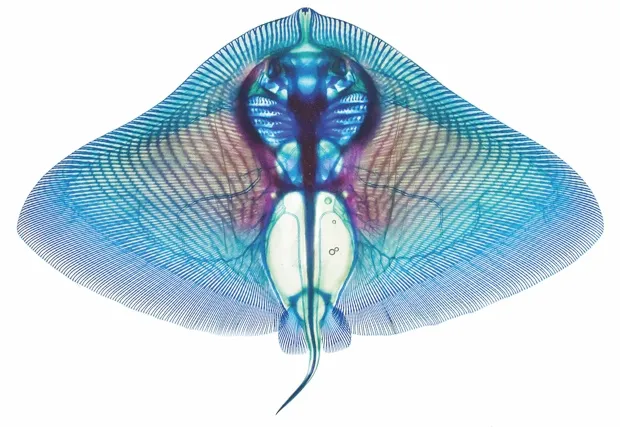
Butterfly rays are found in warm oceans and appear to ‘fly’ through the water by moving their fins up and down. Interconnected segments of the fine fin rays, visible in this stained image, could be the key to translating that up-down motion into underwater flight. As the skeletons of rays, skates and sharks are made of cartilage and not bone, they stain blue rather than red.
3
Bonnethead shark (Sphyrna tiburo)

While chasing prey, bonnethead sharks turn incredibly sharply. Scientists originally thought their odd-shaped heads might help their acrobatics, but their heads stay flat as they turn – so probably not. Summers' bonnethead scan revealed their secret. Most sharks are circular in cross-section behind their heads. The bonnethead’s body is shaped like a pumpkin seed making it super aerodynamic. “That means they can turn really well,” says Summers.
4
Tube-snout (Aulorhynchus flavidus)
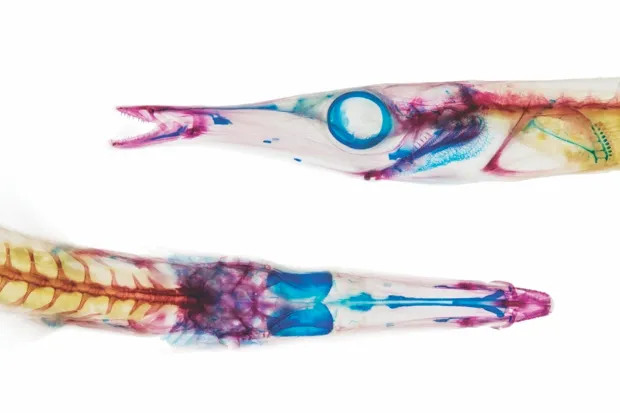
Relatives of seahorses, tube-snouts are the size of pencils and often swim together in large schools. The females are drab and well-camouflaged, while the males have shining patches on their snouts and bright red fins. Females lay eggs on kelp, sticking them in place with goo secreted by their kidneys. Males then guard the nests against predators.
5
Spotfin hatchetfish (Thoracocharax stilettos)
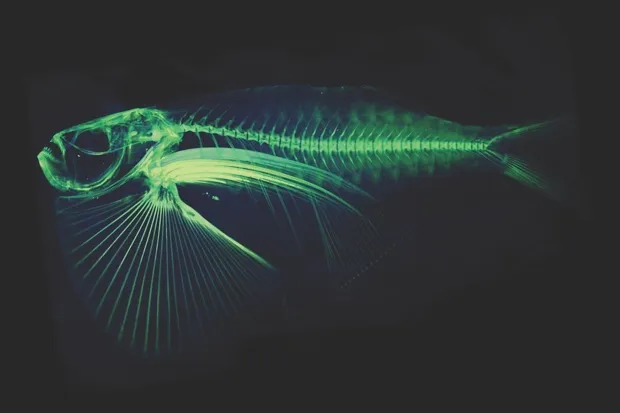
Hatchetfish frequently leap from the water. The buzzing sound they make while flying through the air led people to believe they flap their fins as wings. In fact they glide, holding their fins still. A quarter of their body mass is made up of huge pectoral muscles, giving them pre-flight propulsion. The deep belly adds stability during take-off and landing.
6
Pirapitinga (Piaractus brachypomus)
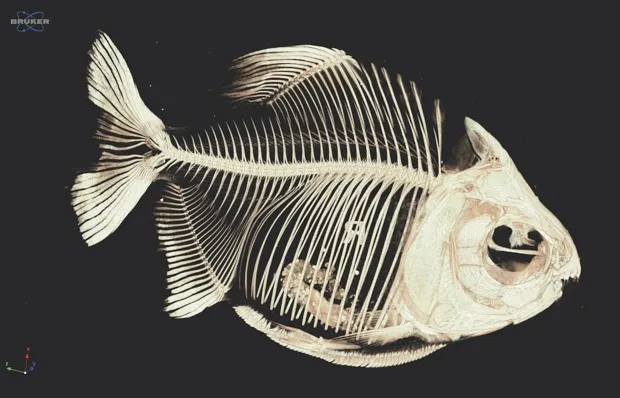
The chomping teeth of these fish make them look like they stole a set of human dentures. Though related to piranhas, pirapitinga are harmless herbivores that chew on seeds and nuts. They belong to a group of fish called the serrasalmids, which are well ahead in the race to #ScanAllFish, with 50 out of 90 species already in the database.
7
Fangtooth (Anoplogaster cornuta)
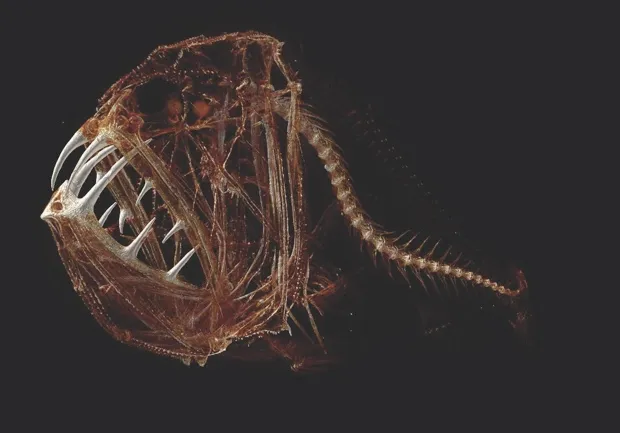
Lurking hundreds of metres beneath the waves, these aggressive predators have the largest teeth relative to body length of any sea creature. The two front lower teeth are so long that they slot into grooves on either side of the brain when the fish shuts its mouth. Juveniles lack these impressive fangs and for over a century, scientists thought they were a separate species.
8
Hogchoker (Trinectes maculatus)
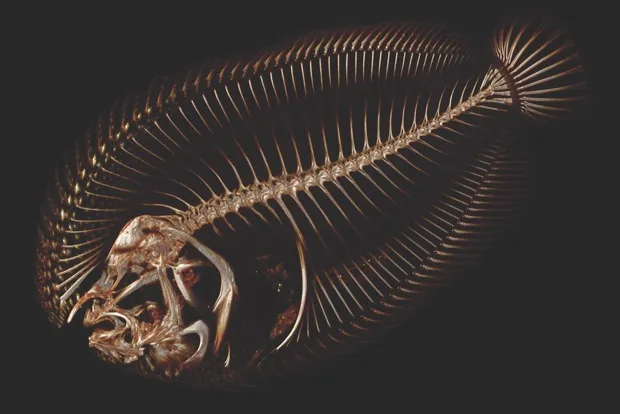
Like all flatfish, hogchokers begin life as larvae with a normal, upright stance and one eye on each side of the body. Then comes a point when one of their eyes gradually slides over the head to join the other. It can be either eye that moves, but in the case of the hogchoker it's the left.
9
Scalyhead sculpin (Artedius harringtoni)
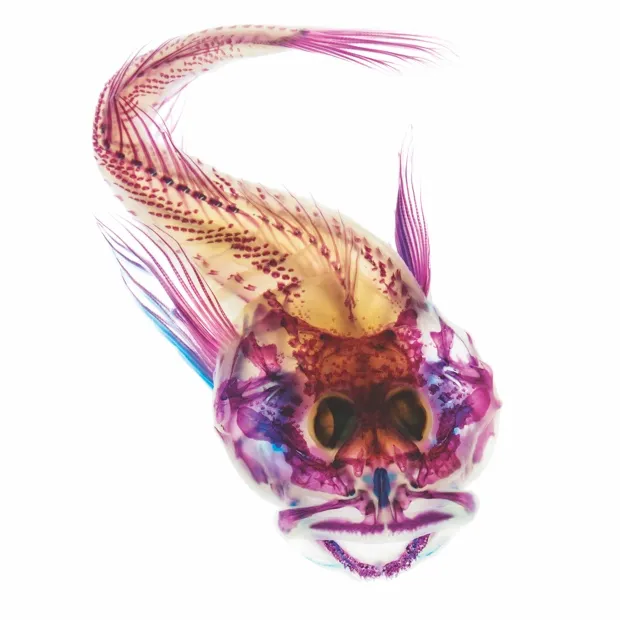
Scalyhead sculpins live in coastal regions of the western US and British Columbia. Despite being just 10 centimetres long, the males are highly territorial and will guard their mate’s eggs until they hatch out.
This is an extract from issue 332 of BBC Focus magazine.
Subscribe and get the full article delivered to your door, or download the BBC Focus app to read it on your smartphone or tablet. Find out more
Follow Science Focus onTwitter,Facebook, Instagramand Flipboard
